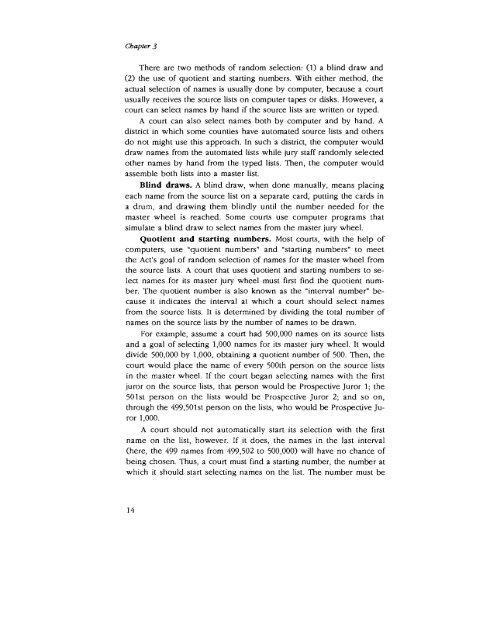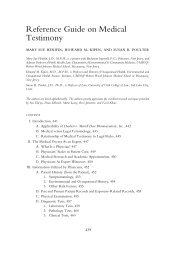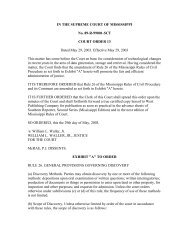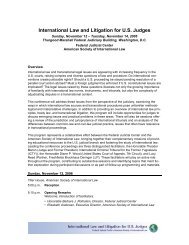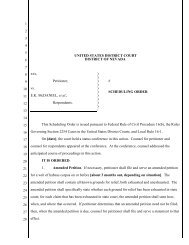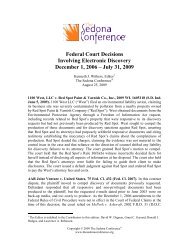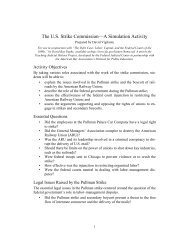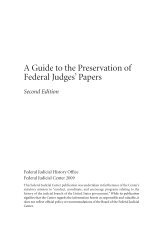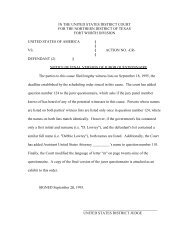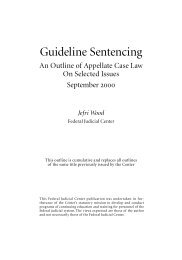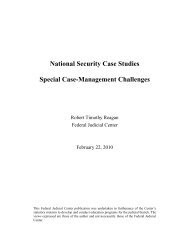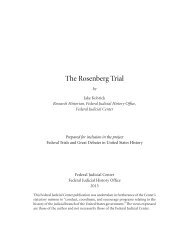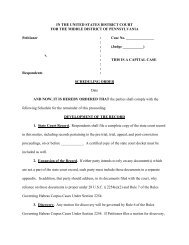Handbook on Jury Use in the Federal District Courts
Handbook on Jury Use in the Federal District Courts
Handbook on Jury Use in the Federal District Courts
You also want an ePaper? Increase the reach of your titles
YUMPU automatically turns print PDFs into web optimized ePapers that Google loves.
Chapter 3<br />
There are two methods of random selecti<strong>on</strong>: (1) a bl<strong>in</strong>d draw and<br />
(2) <strong>the</strong> use of quotient and start<strong>in</strong>g numbers. With ei<strong>the</strong>r method, <strong>the</strong><br />
actual selecti<strong>on</strong> of names is usually d<strong>on</strong>e by computer, because a court<br />
usually receives <strong>the</strong> source lists <strong>on</strong> computer tapes or disks. However, a<br />
court can select names by hand if <strong>the</strong> source lists are written or typed.<br />
A court can also select names both by computer and by hand. A<br />
district <strong>in</strong> which some counties have automated source lists and o<strong>the</strong>rs<br />
do not might use this approach. In such a district, <strong>the</strong> computer would<br />
draw names from <strong>the</strong> automated lists while jury staff randomly selected<br />
o<strong>the</strong>r names by hand from <strong>the</strong> typed lists. Then, <strong>the</strong> computer would<br />
assemble both lists <strong>in</strong>to a master list.<br />
Bl<strong>in</strong>d draws. A bl<strong>in</strong>d draw, when d<strong>on</strong>e manually, means plac<strong>in</strong>g<br />
each name from <strong>the</strong> source list <strong>on</strong> a separate card, putt<strong>in</strong>g <strong>the</strong> cards <strong>in</strong><br />
a drum, and draw<strong>in</strong>g <strong>the</strong>m bl<strong>in</strong>dly until <strong>the</strong> number needed for <strong>the</strong><br />
master wheel is reached. Some courts use computer programs that<br />
simulate a bl<strong>in</strong>d draw to select names from <strong>the</strong> master jury wheel.<br />
Quotient and start<strong>in</strong>g numbers. Most courts, with <strong>the</strong> help of<br />
computers, use "quotient numbers" and "start<strong>in</strong>g numbers" to meet<br />
<strong>the</strong> Act's goal of random selecti<strong>on</strong> of names for <strong>the</strong> master wheel from<br />
<strong>the</strong> source lists. A court that uses quotient and start<strong>in</strong>g numbers to select<br />
names for its master jury wheel must first f<strong>in</strong>d <strong>the</strong> quotient number.<br />
The quotient number is also known as <strong>the</strong> "<strong>in</strong>terval number" because<br />
it <strong>in</strong>dicates <strong>the</strong> <strong>in</strong>terval at which a court should select names<br />
from <strong>the</strong> source lists. It is determ<strong>in</strong>ed by divid<strong>in</strong>g <strong>the</strong> total number of<br />
names <strong>on</strong> <strong>the</strong> source lists by <strong>the</strong> number of names to be drawn.<br />
For example, assume a court had 500,000 names <strong>on</strong> its source lists<br />
and a goal of select<strong>in</strong>g 1,000 names for its master jury wheel. It would<br />
divide 500,000 by 1,000, obta<strong>in</strong><strong>in</strong>g a quotient number of 500. Then, <strong>the</strong><br />
court would place <strong>the</strong> name of every 500th pers<strong>on</strong> <strong>on</strong> <strong>the</strong> source lists<br />
<strong>in</strong> <strong>the</strong> master wheel. If <strong>the</strong> court began select<strong>in</strong>g names with <strong>the</strong> first<br />
juror <strong>on</strong> <strong>the</strong> source lists, that pers<strong>on</strong> would be Prospective Juror 1; <strong>the</strong><br />
501st pers<strong>on</strong> <strong>on</strong> <strong>the</strong> lists would be Prospective Juror 2; and so <strong>on</strong>,<br />
through <strong>the</strong> 499,501st pers<strong>on</strong> <strong>on</strong> <strong>the</strong> lists, who would be Prospective Juror<br />
1,000.<br />
A court should not automatically start its selecti<strong>on</strong> with <strong>the</strong> first<br />
name <strong>on</strong> <strong>the</strong> list, however. If it does, <strong>the</strong> names <strong>in</strong> <strong>the</strong> last <strong>in</strong>terval<br />
(here, <strong>the</strong> 499 names from 499,502 to 500,000) will have no chance of<br />
be<strong>in</strong>g chosen. Thus, a court must f<strong>in</strong>d a start<strong>in</strong>g number, <strong>the</strong> number at<br />
which it should start select<strong>in</strong>g names <strong>on</strong> <strong>the</strong> list. The number must be<br />
14


